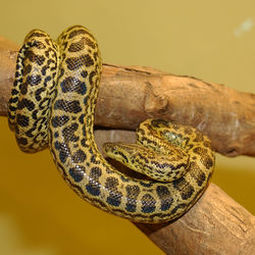Yellow AnacondaEunectes notaeus |

Custom Search
|
|
The yellow anaconda (Eunectes notaeus) is a non-venomous boa species found in the southern regions of South America, including Paraguay, Bolivia, Uruguay, southwestern Brazil and northeastern Argentina.
There are no subspecies are currently recognized by scientists. They are also known by other common names such as Sucuri Amarela (in Brasil) and Paraguayan Anaconda. The yellow anaconda prefers mostly aquatic habitats, these include marshlands, swamps or the banks of slow-moving rivers and streams, but they are also found in forests searching for larger prey. During drought periods yellow anacondas use caves for shelter, and are found in holes that still retain water, along the river banks. During the rainy season they are mostly found hunting in treeless flooded areas. They belong to the family of snakes, Boidae, which contains pythons, boas and the green anaconda, the world’s largest snake. Even though yellow anacondas are much smaller their cousin the green anaconda (Eunectes murinus), they can reach a length of up to 4.6 meters, but the average adult size is around 3 meters.

Much like their cousin the green anaconda, female snakes are longer and heavier than males, and can reach a length of 4.6 m, while males can measure up to 3.7 m in length.
Although exceptionally large snakes can weigh 40 to 55 kg (88 to 121 lb) or even more, their average weight is about 25 to 35 kg (55 to 77 lb). The yellow anaconda has a yellow, golden-tan or yellowish-green base color with brown or blackish bands and spots throughout the entire body, this provides great camouflage both in forest vegetation or murky waters. Once a yellow anaconda reaches adult size, they have few natural predators, but young yellow anacondas being smaller are more vulnerable. They are hunted and killed by Crab-eating foxes, tegu lizards, spectacled caimans, cats and dogs, raccoons, raptors such as the Crested Caracara and even larger anacondas . The yellow anaconda average lifespan in the wild is around 15 to 20 years. Diet / Feeding
Yellow Anacondas are generalist carnivores, and prey mainly on animals found in wetland and riparian areas within its range. The yellow anaconda diet consists mainly of small mammals, birds and bird eggs, turtles, lizards, other snakes, fish and caimans. The young snakes eat mostly fish until they are big enough to capture larger prey. Their size as adults make them capable of killing larger animals like brocket peccaries, deer or capybaras. Although they hunt live prey, on occasion the will scavenge dead animals and eat carrion. They are considered ambush predators, but yellow anacondas sometimes also actively hunt on land. They are powerful constrictors, suffocating their prey by wrapping themselves around it and consume it whole, head first by unhinging their jaws. Since their digestive system is somewhat slow it may eat only every few days or months, depending on the last prey's size. In the wild they hunt mostly from June to November, during drier periods when wetlands areas have shrunk. But like other snakes the Yellow Anaconda can survive long periods without eating. Reproduction Yellow anacondas are solitary animals, except in breeding season between April and May, when they form breeding balls the consist of one female and several males. The females attract mates through pheromones, males will follow this pheromone trail and once they encounter the female courtship begins. The courtship usually takes place in water and it may last for quite some time, some breeding balls have been recorded to stay together for up to a month. The males compete for the female, and normally the largest one wins successfully outcompeting the other males. They are ovoviviparous and the gestation period lasts approximately six months, where the females incubate the eggs inside their bodies, and then give birth to fully developed live young. There is great variation in litter size for wild individuals ranging from 7 to 80 hatchlings, with an average of 20. The young yellow anacondas are about 60 cm in length and immediately able to live on their own. These snakes become sexually mature at around 3 to 4 years of age.
Conservation / Threats
The yellow anaconda as yet to be evaluated by the IUCN but the species listed on Appendix II of CITES. The main threats to the species are poaching for their skin and collection in the wild for zoos and the exotic pet trade. They are also killed out of fear and their habitat is also being destroyed. Anaconda trade is prohibited in most South American countries, but some countries do have export quotas to zoos, research or for the pet trade. The yellow anacondas available in the pet trade are quite expensive, and have a reputation for being unpredictable and dangerous. Back in 2012 the species importation and transport and sale across state lines was banned in the US. In an attempt to prevent the yellow anaconda from becoming yet another invasive species, like other invasive snakes found in Florida. |
Did You Know?
The black mamba is considered the world’s fastest snake as it can move at up to 20 km/h. Scientific Classification |
© 2014 Snake Facts About Us | Privacy Policy | Contact







